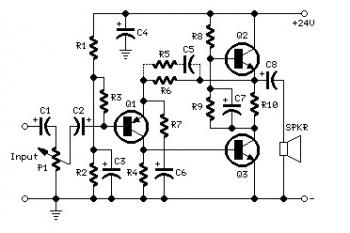Home »
Transistored Amplifier
» 5W Audio Amplifier circuit based BD439
5W Audio Amplifier circuit based BD439
This audio amplifier circuit built based power transistor BD439, capable to deliver up to 5W audio output.
Components List:
P1 = 47K Log. Potentiometer
R1 = 100K - 1/4W
R2 = 12K - 1/4W
R3 = 47K - 1/4W
R4 = 8K2 - 1/4W
R5 = 1K5 - 1/4W
R6 = 2K7 - 1/4W
R7,R9 = 100R - 1/4W
R8 = 560R - 1/2W
R10 = 1R - 1/2W
C1,C2 = 10µF/63V
C3 = 47µF/25V
C4 = 100µF/35V
C5 = 150nF
C6,C7 = 220µF/25V
C8 = 1000µF/25V
Q1 = BC560C
Q2,Q3 = BD439
Circuit Notes:
If needed, R2 could be modified to get 13V across C8 positive lead and negative ground.
Q2 and Q3 should be mounted on a finned heatsink of 120x50x25mm. minimum dimensions.
Total electric current drawing of the circuit, recommended measured by inserting the probes of an multimeter across the positive output with the power supply and the positive rail input of the amplifier, should be 700mA. Adjust R8 to acquire this value if needed.
Add R5 and C5 if the bass-boost facility is needed.
5W Audio Amplifier circuit based BD439 Source
About Audio Amplifier
An audio amplifier is an electronic amplifier that amplifies low-power audio signals (signals composed primarily of frequencies between 20 - 20 000 Hz, the human range of hearing) to a level suitable for driving loudspeakers and is the final stage in a typical audio playback chain.
The preceding stages in such a chain are low power audio amplifiers which perform tasks like pre-amplification, equalization, tone control, mixing/effects, or audio sources like record players, CD players, and cassette players. Most audio amplifiers require these low-level inputs to adhere to line levels.
While the input signal to an audio amplifier may measure only a few hundred microwatts, its output may be tens, hundreds, or thousands of watts. More explanation about power audio amplifier can be found at wikipedia.org
An audio amplifier is an electronic amplifier that amplifies low-power audio signals (signals composed primarily of frequencies between 20 - 20 000 Hz, the human range of hearing) to a level suitable for driving loudspeakers and is the final stage in a typical audio playback chain.
The preceding stages in such a chain are low power audio amplifiers which perform tasks like pre-amplification, equalization, tone control, mixing/effects, or audio sources like record players, CD players, and cassette players. Most audio amplifiers require these low-level inputs to adhere to line levels.
While the input signal to an audio amplifier may measure only a few hundred microwatts, its output may be tens, hundreds, or thousands of watts. More explanation about power audio amplifier can be found at wikipedia.org


0 comments:
Post a Comment